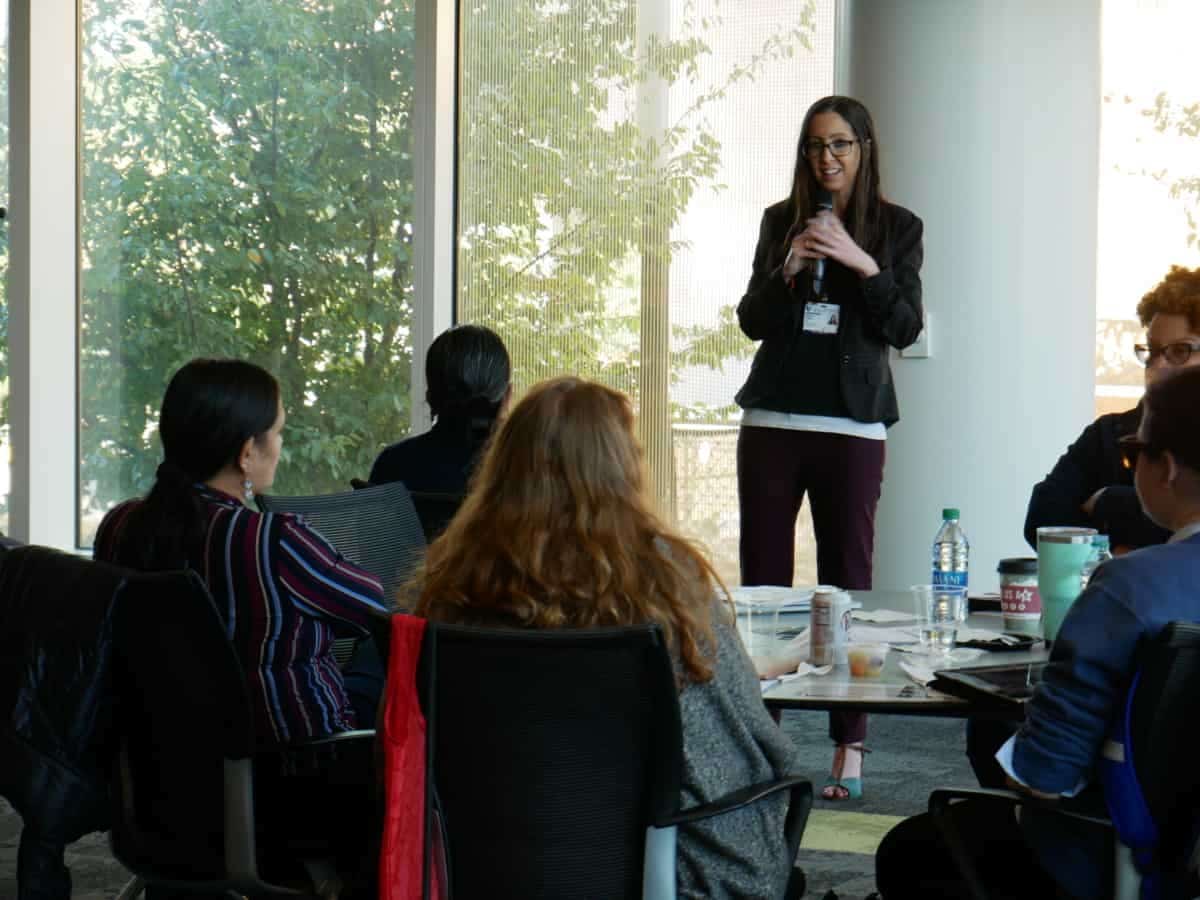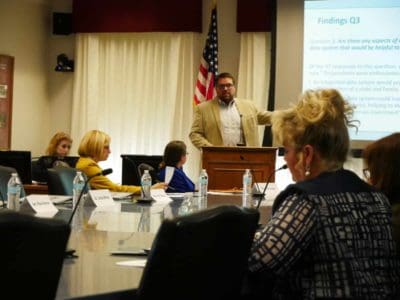

Trauma can have lasting effects on the minds and lives of young children and those that care for them. That’s why early childhood faculty across the state’s postsecondary systems are being trained on trauma-informed teaching.
Angela Tunno, psychologist and medical instructor at Duke University, walked community college and university faculty who teach soon-to-be early educators through how to help their students care for and teach children who show symptoms from traumatic events like abuse, neglect, the loss of a parent, or natural disasters. Tunno encourages those interacting with children who might be reliving past trauma to switch from asking, “What’s wrong with you?” to, “What happened to you?” Catching signs of trauma and helping children cope with its impacts, she said, are the most effective in the early years of life.
“That kind of mental shift really allows for a space of understanding, warmth, and being able to recognize those signs in a way that can change a course of a life,” Tunno said.
The Winer Family Foundation and ChildTrust Foundation are funding this work through the Center for Child & Family Health, which started with a training back in March in Winston-Salem for faculty at 29 community colleges. Friday’s training at N.C. State University provided access for those in the eastern part of the state and — for the first time — brought together community college faculty and B-K coordinators at four-year institutions.
“It’s our first joint training together,” said Cyndie Osborne, Stanly Community College’s early childhood education coordinator and head of NC ACCESS, a state chapter of a national group of early childhood community college faculty.
The concept of “adverse childhood experiences (ACES)” has gained popularity in education spheres in recent years, but Tunno said there’s so much more to trauma than the one study where the term originated, which only accounted for certain negative experiences. Tunno emphasized to community college faculty that traumatic symptoms look different in every child and often show up in varying ways depending on age. Since young children often can not verbalize their emotions, reliving trauma can show up as aggression, regressed development, separation anxiety, or occupation with traumatic events through play.
Tunno said young children experience the world through their senses and that triggers can cause distress that is hard to regulate.
“They might not be able to remember, but their body knows,” Tunno said.
By the time early elementary school rolls around, common symptoms are school absence, poor academic performance, difficulty paying attention, or talking about the event constantly.
She walked faculty through strategies to deescalate episodes. The part of the brain that goes into survival mode — choosing “fight, flight, or freeze” — is overworked in individuals who have experienced trauma. During an episode, Tunno said, this emotional brain overtakes the reasoning brain.
Tunno repeated term “connect, then redirect.” This means helping children calm down physiologically before trying to reason with the child. Tunno said helping children recognize the physical through breathing exercises, physical movement, or naming aspects of a room aloud can bring them back to the present moment.
Tunno said individuals who work with people experiencing trauma and hear of or see intense situations through their work can have similar symptoms as if they themselves experienced trauma. This is called “secondary traumatic stress.”
“It’s always important to look at how are you caring for your providers who care for children, especially children who have a lot going on in terms of what they’ve experienced, big behaviors, big emotional feelings and escalations, and little resources,” Tunno said. “The work can be draining. It can also be very rewarding.”
She encouraged faculty to share self-care strategies with their early childhood students and said it’s important for organizations to provide support networks and positive environments for the early educator workforce.
“It doesn’t have to have this impact that affects your work if engaging in things like self-care, but even more importantly, organizations focusing on workforce care — the organization wrapping around their workforce to support the people who are doing that work, so they never feel alone, they feel connected to other people, they feel like their wellness is valued.”
Osborne said her students are often working through their own trauma as they learn about caring for children.
“We know many of them come into the field and they may not have dealt with… past trauma from their childhood and existing current trauma like being homeless, or being in a domestic violence situation, or not being able to afford to keep the lights on, or whatever the case is,” Osborne said.
What Osborne did not anticipate was a third layer of the training: knowledge and support for the faculty themselves.
“We wanted it to be two-fold, we need to know how to educate our students to work with young children, but we also need to know how to work with our students,” she said. “But then we went, ‘Oh, and maybe take care of ourselves.'”
For Craven Community College early childhood coordinator Terri Colón, a video during the training that showed the impact of a drama teacher on a student who had struggles in her childhood stuck out.
“So many times, we have students in our programs that … lead very tragic lives,” Colón said. “I see them every single semester. Sometimes I feel like a therapist, and I feel very unqualified. What I realized when I watched that video was, I’m not their therapist, I’m their mentor and their educator.”
Colón said she felt empowered to know that her direction to resources and help as a teacher was enough.
“That was like a defining moment for me, because it gave me peace,” she said. That doesn’t mean not recognizing her students’ struggles — helping students get connected with the right resources to be successful remains a priority for Colón. She said she wanted to start asking one question at the beginning of the semester, “What do you need from me to help you be successful?”
“That… creates a safe place, a place for the student to understand that they can work and ask for help when they need help, and it also helps communicate to me, what do they need? Maybe they don’t have reliable internet … Maybe they don’t have a car to get to our face-to-face class. And so those are the things that at least I can at least point them in the right direction for resources. I may not fix it for them but I might be able to point them in a direction.”
Editor’s Note: The ChildTrust Foundation supports the work of EducationNC.
Correction: A previous version of this article misspelled Cyndie Osborne’s name and affiliated the Center for Child & Family Health with Duke University. The center is a stand-alone nonprofit.


